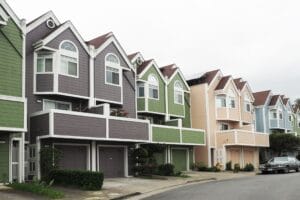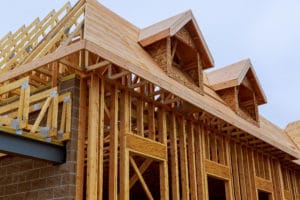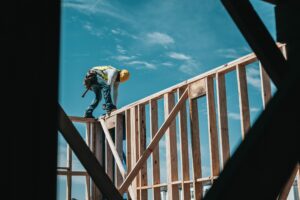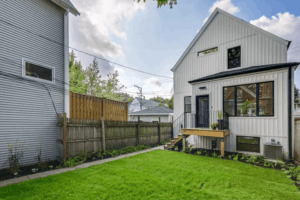Still no place to live: The local barriers to the accessory dwelling unit revolution
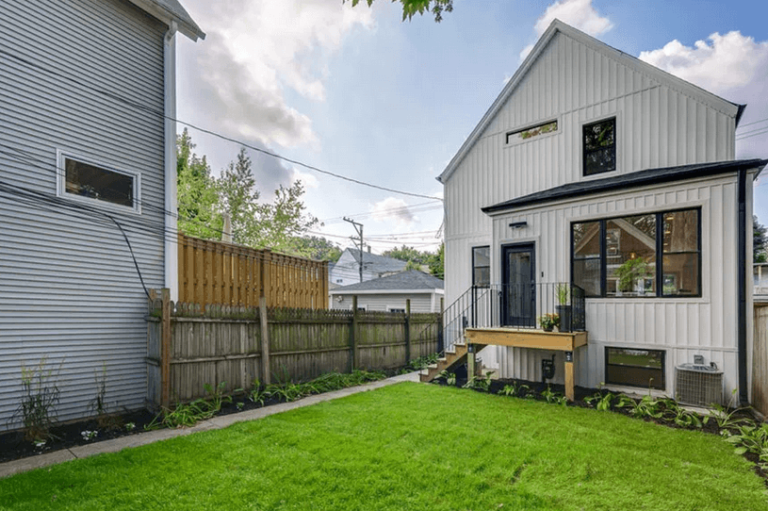
Still no place to live: The local barriers to the accessory dwelling unit revolution
A Pacific Legal Foundation report
WHEN JASON AND ELIZABETH Riddick began considering their options for building an accessory dwelling unit (ADU) on their Malibu home, they thought their prayers were answered.
The Riddicks were trying to find an option for housing Elizabeth’s 82-year-old mother in a way that allowed her to stay close to family while receiving the care she needs for her numerous medical issues, including immunodeficiency. Attaching an ADU to the house would allow Elizabeth’s mother, Renee Sperling, to live with her family but still maintain her own space. This would enable her to get the care she needs while preserving her privacy and protecting her from the risk of contracting a contagious illness posed by close proximity to the family and their three young children.
It was the perfect solution for the Riddicks and Renee. But city officials of Malibu didn’t care about any of that.
When the Riddicks applied for permits to construct the ADU for Renee, the city rejected them on the erroneous basis that the proposed ADU conflicted with the Malibu Local Coastal Program. The city even denied the Riddicks’ request for a disability accommodation for Renee because, according to the city, the Riddicks had other options, like rearranging their home to isolate Elizabeth’s mother in some area of the house, or simply putting Renee in an assisted living home.
Despite California’s recent legislative reforms designed to improve the laws and foster ADU development, many local governments like Malibu have little sympathy for families like the Riddicks, or for communities trying to create more affordable housing options.
And unfortunately, Malibu is not alone in opposing California’s new housing laws:
- San Marino is refusing to comply with the state’s relaxed square footage and siting requirements.
- Coronado is requiring property owners to go through multiple approvals before it will consider an ADU application.
- San Diego County and Encinitas are refusing to comply with the state’s 60-day permit review requirement, taking a half-year or more to act on completed applications.
- Oakland is using ADU applications as an opportunity to force owners of historic homes to make expensive updates to their properties, despite provisions of state law to the contrary.
Each day there is more opposition to ADUs from local governments and overreaching bureaucrats. In the state of California, ADUs are legal, but in the eyes of many local politicians, they’re not yet welcome.
Why ADUs matter
OUR NATION IS in the midst of a severe and ever-worsening housing crisis. Rents and home prices continue to rise at rates far faster than incomes. Yet year after year, too few homes are built to meet the growing demand from renters, and families with unique housing needs like the Riddicks are left with no good options.
The only way to address this crisis is through increased production of a diverse housing supply priced to serve people at all levels of income.
That is where ADUs come in. ADUs are small homes located on the same lot as an existing single- or multi-family home, such as a garage apartment, a basement unit, or a backyard cottage. While ADUs can’t solve the country’s housing crisis, they are an important piece of a property rights and free market-based solution.
ADUs have the potential to provide quality housing at low cost in previously built-out urban and suburban communities. This is particularly true in areas where new development is severely limited and single-family homes are often unaffordable to many people. ADUs are inherently affordable because, in addition to being small, they use existing land, buildings, and infrastructure.
ADUs, furthermore, benefit both the housing and rental market. For property owners, ADUs provide an opportunity for older family members to age in place, for college-aged children to gain some independence, or for families to secure rental income to offset housing costs and property tax increases. For potential tenants, ADUs provide small, affordable alternatives in an overburdened and highly competitive rental market.
The primary barriers to ADU production are zoning laws and land-use regulations, which often subject ADUs to a costly and time-consuming discretionary permit review process. And while some states are passing legislation and reforms to make obtaining approval for ADUs easier and faster, local governments in those states are increasingly setting up illegal roadblocks to ADU approval and construction.
California law improves while California cities reject reform
IN RECENT YEARS, CALIFORNIA has addressed many of the regulatory barriers to ADUs that had existed in the state. In 2016 and 2019, the state passed a series of reforms aimed at encouraging private development of ADUs through strong private property rights and the free market.
Cal. Gov. Code § 65852.2 states that most homeowners have a right to build at least one ADU on their property, as long as the ADU meets certain simple and pre-published criteria, such as setbacks and square footage.
Section 65852.2 provides certainty to homeowners by forbidding local government from imposing rules that are more restrictive than state law and requiring that cities and counties approve applications via a simple over-the-desk process within 60 days of filing. The idea behind this reform was to encourage private development of low-cost housing by making the permit decisions predictable, speedy, and inexpensive.
For the most part, this reform has worked. Cities like Los Angeles have permitted thousands of new inexpensive homes each year since the state reformed its ADU law. But California’s property rights-first approach to ADUs is so foreign to local governments that many cities and counties have been balking at the state mandate, adopting policies that delay and drive up the cost of new ADUs.
Pacific Legal Foundation obtained public records from San Diego and Riverside Counties (two of the most populous counties in the state) to determine whether local governments are abiding by the new 60-day permit-approval period, which took effect in January 2020.
Unfortunately for California residents, local governments are failing miserably to abide by the new state law.
- San Diego County took a median of 187 days to issue an ADU or Junior ADU building permit after January 2020. Permits issued prior to the new law took a median of 112 days to be issued. Only 52% of permits issued prior to the new law fell within the previously required 120-day mark.
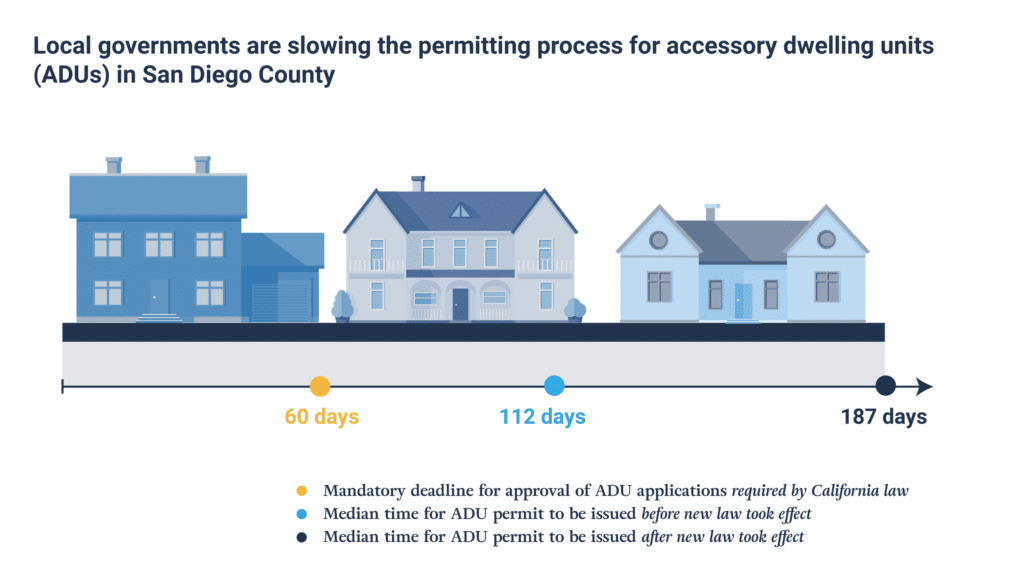
Currently, only 5% of permits issued by the county met the state’s 60-day deadline. Many times, the permitting process is held up by excessive fees or approvals needed from other departments within the county. As of July 21, 2021, there are 587 pending applications, of which 90 were submitted prior to 2020. If these permits were issued today, the median wait time would be 255 days after the application was submitted.
- Riverside County took a median of 162 days to issue ADU building permits. Currently, only 2% of permits issued after 2020 fell within the state’s 60-day deadline. Prior to 2020, it took Riverside 181 days to issue a permit. Only 35% of those permits issued fell within the previously required 120-day period.
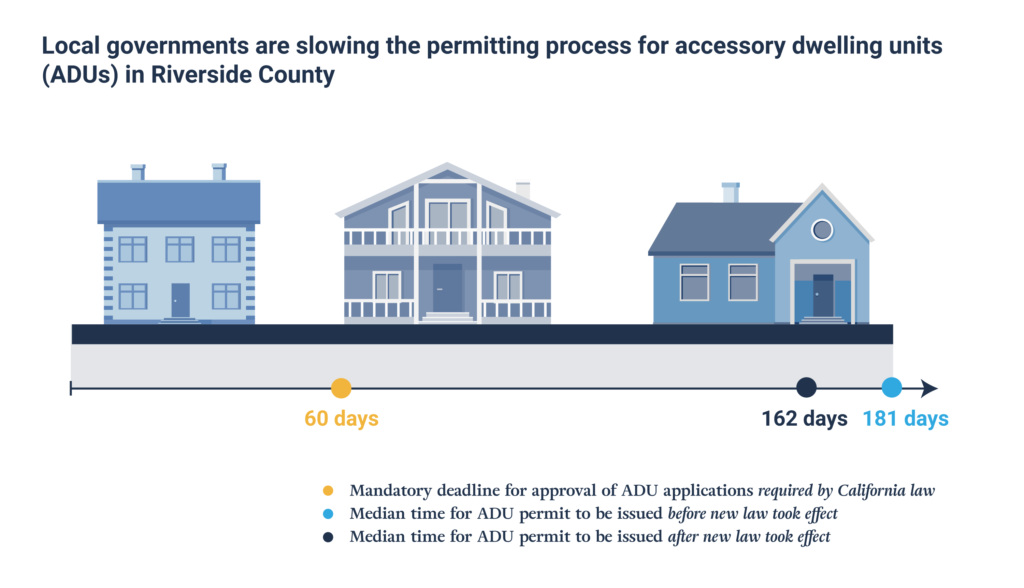
While the COVID-19 pandemic undoubtedly slowed down these government offices, the fact that San Diego County’s and Riverside County’s permit process was illegally long prior to 2020, and is still illegally long over a year after the pandemic began, proves that this isn’t simply a problem created by COVID-19 shutdowns.
Local governments must make ADU approvals certain, speedy, and low cost
IN ADDRESSING LOCAL GOVERNMENTS’ resistance to ADUs, Pacific Legal Foundation is suing cities and counties throughout California to ensure that local governments do not unreasonably interfere with an owner’s right to build ADUs where appropriate. PLF has also teamed up with the Better Cities Project to create model legislation that local governments can utilize while crafting their own ADU policies.
PLF’s litigation and model legislation are aimed at advancing a property rights-based solution to the housing crisis by ensuring that the permit approval process is:
- Certain: Property owners need to know what is and isn’t allowed before they invest time and money in a housing project. For too long, cities and counties have enacted impenetrable and confusing codes that require professionals to decipher. And even then, permitting was highly unpredictable and subject to local planner discretion. Returning certainty to land use codes will empower owners to help solve the housing crisis while helping themselves and their families as well.
- Speedy: Housing delayed is housing denied. One of the consequences of confusing land use laws and unbridled local discretion has been the incredible amount of time that an application takes before the owner receives a final decision. The lengthy and uncertain process drives off many potential small home builders, leaving very few options for new housing.
- Low cost: In order to build more housing of all types and across all price points, the permit process needs to be as inexpensive as possible. For decades, however, state and local governments have used the permit process to exact a wide array of fees from home builders, which has resulted in skyrocketing home prices and rents. Eliminating unnecessary costs will encourage families and single homeowners to build homes and allow those priced out of the current market to obtain affordable housing.
Only when all three conditions are firmly established will property owners feel comfortable adding to the housing supply and maximizing the utility and value of their land.
The fight for ADUs is about more than affordable housing
WHEN THE RIDDICK FAMILY began their process for building an ADU for Renee, they never imagined the bureaucratic and legal nightmare that was in front of them. And while the Riddicks’ saga to build an ADU for their elderly mother is emblematic of the struggles families and property owners across the country are going through, the Riddicks’ fight is more personal than a fight over bad government policy.
The Riddicks are fighting to utilize their property in a way that best serves their family (and doesn’t affect anyone else). They have a right to do that, and California law reinforces that right.
It’s time for cities like Malibu to respect that right too.





